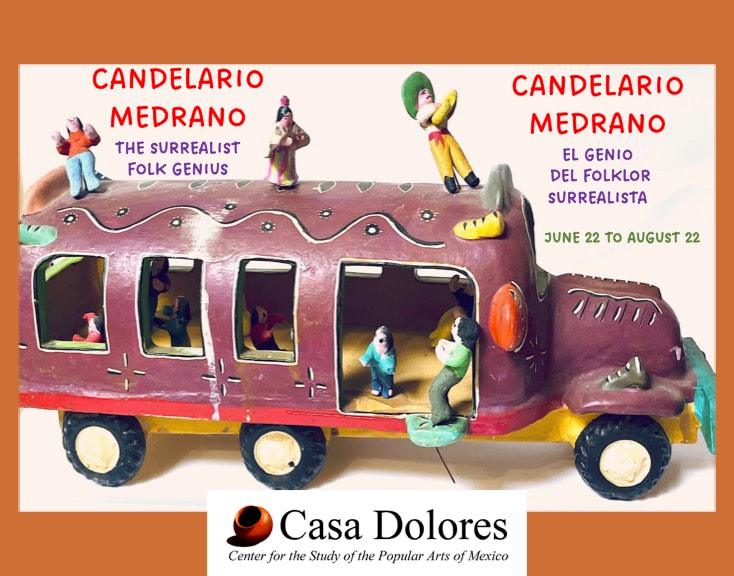CANDELARIO MEDRANO, THE SURREALIST
FOLK GENIUS
JUNE 22 TO AUGUST 22
Candelario Medrano (1918 – 1986) was one of the top figural ceramicists in México. He was the adopted son of Julián Acero, the finest ceramic toy maker in the village of Santa Cruz de las Huertas in the state of Jalisco. Candelario followed in his father’s footsteps and began making ceramic toy whistles of mermaids and roosters.
Candelario sold whistles at the Tonalá Thursday markets, which is where he met world-renown ceramicist Jorge Wilmot (1928 – 2012). Wilmot was impressed with the “unusual wrought and lively” dieciochos and veinticuatros, or the eighteens and twenty-fours, which were the prices of the whistles. Jorge suggested to Candelario that he should put his animals on large structures, such as arks, apartment buildings and buses. Jorge even sketched a design to show him. Excited about the idea to evolve his art, Candelario began making vignettes of happy people on what were, to him, miracles of the modern age – brightly painted airplanes, taxis, boats, and trucks.
The artist also explored naguales, shape-shifters and mythic beings with origins in Mesoamerican folk religions. A nagual is a protective animal spirit or boogie man, and all of Candelario’s naguales were painted in wonderfully bright colors.
Due to a bout with alcoholism, Candelario did create darker pieces that presented figures in violent poses yet remained wildly colorful.
While some view the nagual as a blessing, to Candelario they brought misery. Themes of poverty and the supernatural inundate his work and have their roots both in things he saw around him and the rich folkloric tales he was told as a child. He died in poverty in 1986, while his work sold in American galleries for hundreds of dollars.
Candelario’s pieces were collected by Nelson Rockefeller and other savvy connoisseurs of Mexican popular art. Medrano remains a celebrated master of folk ceramics and his work continues to be celebrated and prized around the world.
CANDELARIO MEDRANO, EL GENIO
DEL FOLKLOR SURREALISTA
Del 22 de Junio al 22 de Agosto
Candelario Medrano (1918-1986) fue uno de los artistas populares principales en México. Era el hijo adoptivo de Julián Acero, el mejor creador de juguetes de cerámica en el pueblo de Santa Cruz de las Huertas en el estado de Jalisco. Candelario siguió los pasos de su padre y empezó a hacer silbatos de juguete hechos de cerámica con formas de sirenas y gallos.
Candelario vendió los silbatos en los mercados de los jueves en Tonalá, en donde conoció al ceramista de renombre mundial Jorge Wilmot (1928-2012). Wilmot estaba impresionado con lo “inusual forjado, y animado” dieciochos y veinticuatros, que eran los precios de los silbatos. Jorge le sugirió a Candelario que debería de poner los animales en estructuras grandes, como arcas, edificios de apartamentos y autobuses. Jorge también dibujó un diseño para enseñárselo. Contento de la idea para evolucionar su arte, Candelario empezó a hacer viñetas de personas felices lo que para él, eran milagros de la era moderna- brillantemente pintado aviones, taxis, barcos, y camiones.
Debido al combate con el alcoholismo, Candelario creó piezas oscuras, que estaban pintadas vistosamente y presentadas en situaciones violentas. Aunque algunos ven al nagual como una bendición, a Candelario le trajeron miseria. Temas de pobreza y lo sobrenatural inundan su trabajo y tienen raíces en cosas que vio a su alrededor y los cuentos folklóricos que le contaban cuando era niño. Murió en la pobreza en 1986, mientras sus artesanías fueron vendidas en galerías americanas por cientos de dólares.
Las piezas de Candelario fueron coleccionadas por Nelson Rockefeller y otros colectores de arte popular Mexicana. Candelario permanece como un maestro muy celebrado de cerámicas folklóricas y su trabajo sigue siendo coleccionado por todo el mundo.

